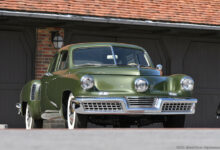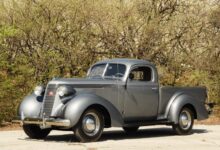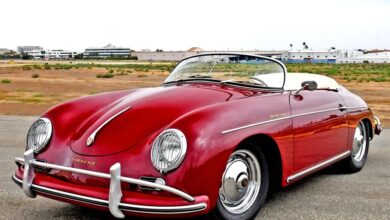Duesenberg Model Js are among those rare collectibles that are of finite numbers and impressive documentation, so many of the 481 built between 1929 and 1940 can be specifically accounted for and discussed in depth. Because of their enormous expense, these Depression-era jewels were often driven by the Who’s Who of the socialite scene. This particular 1931 Model J, with its original Convertible Sedan body by Murphy, was no exception, and with a few updates and some minor refurbishing, it has remained in the care of those who cherish its unique heritage.
The Model Js that Fred and August Duesenberg engineered are arguably the finest automobiles produced in America in their day. Their extremely limited production was a factor of their huge cost, amounting to many multiples of the average person’s salary, as was their complex and advanced engineering, which made them the fastest and most powerful cars on the road. While they are certainly appreciated today, the inherent value of these cars wasn’t always recognized, and there was a period in the 1930s and 1940s when their designs were considered dated and their consumption of fuel, tires and driver’s effort consigned some unfortunate examples to junkyards and wartime scrap-metal drives.

Today, a Model J is evaluated by a number of factors, the key being originality; a car with its original chassis, firewall, engine and body is considered more valuable than one that features replacement components. Our feature Model J is one such original car, although for a time, its appearance was significantly altered. Unlike many Duesenbergs, which change ownership regularly between collectors, this car has belonged to the same family for 50 years. The Watson family of Greenwich, Connecticut, has treated this handsome Model J to two restorations, the most recent being a concours-correct update at the hands of Duesenberg specialist and Pebble Beach Concours d’Elegance Best-In-Show-winning restorer Chris Charlton, of Oxford, Maine’s Classic Car Services.
Connoisseurs refer to Model Js by their engine and chassis (serial) numbers, and in that spirit, the Watson car is J-329 2345. This example was built on the “short” 142.5-inch chassis, and it sports a Convertible Sedan body–number 853–designed and built by the Walter M. Murphy Company of Pasadena, California. It was the 29th of 46 such Duesenberg Model J Convertible Sedans that Murphy bodied. This was one of the Duesenberg catalog’s most popular body styles–although each Convertible Sedan was unique in its details–and Murphy was the automaker’s most favored coachbuilder, bodying 125, or roughly one-third of all factory-purchased Duesenberg J variants.
This $12,650 Convertible Sedan got an impressive start in life at the hands of its first operator, the famed racer and front-wheel-drive Miller campaigner Leon Duray. It is unclear as to whether this Indianapolis 500 lap-speed record holder purchased the car new, or if it was loaned to him as a demonstrator–he was named in a partial list of Duesenberg owners that was printed in the 1931 Duesenberg catalog–but he reported to the company that he used it extensively.
As seen in J. L. Elbert’s Duesenberg: The Mightiest American Motor Car, the racer contacted the automaker in regard to our feature car: “A telegram from Leon Duray in Los Angeles addressed to [sales manager] H. T. Ames at the factory in Indianapolis: ‘CAR IS PERFECT IF THERE IS SUCH A THING COMPLETED FIFTY TWO THOUSAND MILES ON CAR TODAY LEFT SALEM N.H. TUESDAY SEVEN P.M. LEFT FACTORY SIX P.M. THURSDAY ARRIVED HERE EIGHT P.M. SUNDAY SLEEPING SEVEN HOURS EACH NIGHT.”
Following its time with Duray, our feature car spent the next 15 years in and around St. Louis, Missouri, passing through three owners before it was traded in at the local Cadillac dealer. Mr. Norris Allen of St. Louis purchased the Duesenberg from that dealer in January 1936, and would own the car until November 1958. It was he who fitted a White truck transmission and commissioned a re-styling that brought the Model J in line with contemporary trends.
This restyle was superficial, yet it comprehensively changed the character of the car. From the rear, wrap-around bumpers with thick corners replaced the slender two-bar originals, and a well-integrated bustle back trunk was added, off of which hung a rear-mounted spare. Long, pontoon-style enclosed fenders were added, and the headlamps were incorporated into the top-leading edges of the front fenders. Brightwork was minimized and the cowl lamps were deleted. The convertible top, with its thick, blind quarters, went unaltered. The result was a car that appeared, from the rear three-quarters, akin to a four-door 1940 Lincoln Continental.
The Auburn Cord Duesenberg Club’s Duesenberg historian, Chris Summers, notes that the car passed through another pair of hands before being purchased in 1962 for $10,000 by Arthur K. Watson, chairman of the IBM World Trade Corporation and future U.S. ambassador to France. It is believed that Watson had the car returned to its original appearance and mechanical configuration during an early 1960s restoration, and his son, A.K. “Kitt” Watson Jr., grew up with it as his family’s fun car.
“I’ve always remembered the Duesenberg being part of the family,” Kitt explains. “I remember going up to Yale football games in it with my father, and it would always break down on the way home, and we’d have to hitchhike the rest of the way,” he laughs. “My father took it to Gus Reuter, a master Duesenberg technician in Wilton, Connecticut, who worked on it. We had a lot of fun with the car, and we used it in all weather with the top down or up. I used to drive it all over the place. Even Mom used to wheel that thing around, and it’s like driving a school bus at low speeds; I always thought that was pretty impressive.”
That Mrs. Watson drove the Duesenberg was indeed quite a feat, because despite Murphy’s aluminum-intensive coachwork, the Convertible Sedan weighed in excess of 5,000 pounds, and its cast-iron, 420-cu.in. straight-eight engine pressed mightily on those 19-inch wire wheels. But the specifications of this Duesenberg-designed, Lycoming-built engine sound modern even today: full pressure lubrication, aluminum alloy pistons and connecting rods, chain-driven dual-overhead camshafts, four valves per cylinder, 33/4 x 4¾-inch bore and stroke, hemispherical combustion chambers and 265hp at 4,200 RPM and 374-lbs.ft. of torque. Those figures eclipsed anything built in America at the time, and they were made with a comparably low 5.20:1 compression ratio and a 11/2-inch Schebler Duplex Model 6 updraft carburetor; the Watsons’ Model J was upgraded with the high-capacity downdraft Stromberg carburetor that Duesenberg introduced in 1933 production and soon offered as a retrofit kit, so it offers still more power.
The hydraulic 15 x 3-inch drum brakes, 11-inch two-plate clutch and Warner Gear Hi Flex three-speed manual likely also took some effort to operate, although the latter featured a unique, planetary-type spool second gear, instead of a conventional sliding gear, which was designed to be silent and smooth; that middle gear had the impressive ability to take the car up to 90 MPH.
Forty years on, the 1960s restoration that Arthur Watson commissioned was growing tired, so Kitt Watson employed Chris Charlton for a thorough overhaul. “We did this car in 2003-’04. The paint was chipped, and the top needed to be replaced,” Chris recalls. “Kitt had had the engine rebuilt by [preeminent Duesenberg mechanic] Jim Hoe. We knew that it would be good, because he was an excellent mechanic, so we didn’t need to do the engine over, but we did repaint it, polish the aluminum and replate the chrome.
“I didn’t connect that this was that car that had been modified with modern-styled fenders until we were well into the job. Nothing had been cut or modified during the re-style, so at first, I assumed the car had never been changed. After we got into it, I pulled out Fred Roe’s book, Duesenberg: The Pursuit of Perfection, compared the numbers and said, ‘Wow!’ This explained why there were five or six extra holes in the back body section, where they had bolted on that trunk. When the car was put back to its original form, original Duesenberg Model J fenders were reinstalled, so they either used the ones they had taken off of this car or they found another set of correct fenders.
“Unfortunately, the restoration work done back in the 1960s wasn’t like we do it today. The chrome work was poor by modern standards; they’d use a belt sander-type machine, and you’d get these waves, ripples and grind marks that are ungodly looking. We stripped the metal, flat-filed it properly and block-sanded it. We then had to have someone laser-etch all of the detail back into the chrome, things like the manufacturer’s script in the headlamps and the Murphy details in the door sills–our chrome bill was phenomenal.”
Chris worked with Kitt to select the exterior colors. “I don’t know what the car’s original color was, but I’d asked Kitt about changing colors slightly, because I had a hunch that the two tones of blue on it were commercial blues, and I thought it would be appropriate to go with period 1930s shades. Kitt wanted to keep it the same, as his father had chosen those colors,” he explains. “When I started doing paint work in the 1970s, most of the new cars were metallic colors. If you went into an auto body paint shop and told them that you wanted a 1930s color, they had no way of determining what that would be, so they’d hand you a fleet color book, which had solid colors that were used on Mack trucks and the like. For the fun of it, I picked up a 1960s fleet color book, and I found the car’s exact two colors in it–those two tones of blue were tractor-trailer colors.
“I painted some samples of the closest two blues I could get in period 1930s colors and proper tints, which are now referenced by the paint companies’ color libraries, and I brought them to Kitt. I suggested we use these period colors, as opposed to what’s on the car. I told him, ‘We’ll still have your father’s blue, but the car will have an authentic color combination.’ He was very happy with it, so it fulfilled the need to keep the car in his family’s color scheme, and make it look correct, too,” Chris says.
Although it’s been a number of years since Chris’s shop finished the Model J’s restoration, the car remains in top condition. “It’s holding up very well. We’ve re-buffed the paint once or twice since it’s been done. Years ago, there used to be what they called ‘dry down’ in lacquer paint products, and sanding scratches could appear in the surface of the paint. Modern products are all chemically cured, and you might go back to do some superficial light polishing now and then, but for the most part, if it’s not exposed to UV light and kept in dry storage, the finish will hold up. If someone said, ‘Let’s take it to a concours,’ a cleaning and wax would be all that’s necessary.”
Kitt entrusts Chris with the car’s caretaker duties. “We keep the car here in a secure, heated storage area,” Chris says. “When it’s not being used, we’ll start it and run it until the exhaust gets hot, sometimes drive it around the parking lot to keep everything moving. If you don’t do that, they get stiff–the grease solidifies, while the joints and springs stiffen up.”
So how does it feel to have this Watson family heirloom back in perfect shape? “I love driving the car,” Kitt says. “The brakes work extremely well considering the car’s weight. The engine is powerful and will rev easily. First is such a low gear that you’ll get up to about 3 MPH and need to shift, so I usually take off in second. And I’ve gone down the parkway in excess of 80 MPH in it; you’ll get a little shimmy every once in a while, but I think it drives rather nicely. After it was finished, I took my mother for a ride, and she loved it. For its age, it’s pretty durable. I hope I’m that durable when I’m 80.”


